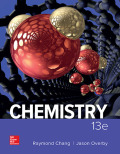
Chemistry
13th Edition
ISBN: 9781260162370
Author: Chang
Publisher: MCG
expand_more
expand_more
format_list_bulleted
Question
Chapter 25, Problem 25.33QP
Interpretation Introduction
Interpretation:
Reason behind for destruction of nylon using acids should be explained.
Concept introduction:
Nylon is a
Expert Solution & Answer
Want to see the full answer?
Check out a sample textbook solution
Students have asked these similar questions
Nylon can be destroyed easily by strong acids.Explain the chemical basis for the destruction.(Hint: The products are the starting materials of thepolymerization reaction.)
Write the chemical structure of a non-biodegradable polymer (Polystyrene) and explain (in one line), based on it's chemical structure why it has this property
Poly(lactic acid) (PLA) has received much recent attention because the lactic acid monomer [CH3CH(OH)COOH] from which it is made can be obtained from carbohydrates rather than petroleum. This makes PLA a more “environmentally friendly” polyester. (A more in-depth discussion of green polymer synthesis is presented in Chapter 30.) Draw the structure of PLA.
Chapter 25 Solutions
Chemistry
Ch. 25 - Prob. 25.1QPCh. 25 - Prob. 25.2QPCh. 25 - Prob. 25.3QPCh. 25 - Prob. 25.4QPCh. 25 - Prob. 25.5QPCh. 25 - Prob. 25.6QPCh. 25 - Prob. 25.7QPCh. 25 - Prob. 25.8QPCh. 25 - Prob. 25.9QPCh. 25 - Prob. 25.10QP
Ch. 25 - Prob. 25.11QPCh. 25 - Prob. 25.12QPCh. 25 - Prob. 25.13QPCh. 25 - Prob. 25.14QPCh. 25 - Prob. 25.15QPCh. 25 - Prob. 25.16QPCh. 25 - Prob. 25.17QPCh. 25 - Prob. 25.18QPCh. 25 - Prob. 25.19QPCh. 25 - Prob. 25.20QPCh. 25 - Prob. 25.21QPCh. 25 - Prob. 25.22QPCh. 25 - Prob. 25.23QPCh. 25 - Prob. 25.24QPCh. 25 - Prob. 25.25QPCh. 25 - Prob. 25.26QPCh. 25 - Discuss the importance of hydrogen bonding in...Ch. 25 - Proteins vary widely in structure, whereas nucleic...Ch. 25 - Prob. 25.29QPCh. 25 - Prob. 25.30QPCh. 25 - Prob. 25.31QPCh. 25 - Prob. 25.32QPCh. 25 - Prob. 25.33QPCh. 25 - Prob. 25.34QPCh. 25 - Prob. 25.35QPCh. 25 - Chemical analysis shows that hemoglobin contains...Ch. 25 - Prob. 25.37QPCh. 25 - What kind of intermolecular forces are responsible...Ch. 25 - Draw structures of the nucleotides containing the...Ch. 25 - Prob. 25.40QPCh. 25 - Prob. 25.41QPCh. 25 - Prob. 25.42QPCh. 25 - Prob. 25.43QPCh. 25 - Prob. 25.44QPCh. 25 - When deoxyhemoglobin crystals are exposed to...Ch. 25 - Prob. 25.46QPCh. 25 - Prob. 25.47QPCh. 25 - Prob. 25.48QPCh. 25 - Prob. 25.49QPCh. 25 - Prob. 25.50QPCh. 25 - Prob. 25.51QPCh. 25 - Assume the energy of hydrogen bonds per base pair...Ch. 25 - Prob. 25.53QP
Knowledge Booster
Similar questions
Recommended textbooks for you
 Introductory Chemistry: An Active Learning Approa...ChemistryISBN:9781305079250Author:Mark S. Cracolice, Ed PetersPublisher:Cengage Learning
Introductory Chemistry: An Active Learning Approa...ChemistryISBN:9781305079250Author:Mark S. Cracolice, Ed PetersPublisher:Cengage Learning Chemistry & Chemical ReactivityChemistryISBN:9781337399074Author:John C. Kotz, Paul M. Treichel, John Townsend, David TreichelPublisher:Cengage Learning
Chemistry & Chemical ReactivityChemistryISBN:9781337399074Author:John C. Kotz, Paul M. Treichel, John Townsend, David TreichelPublisher:Cengage Learning Chemistry & Chemical ReactivityChemistryISBN:9781133949640Author:John C. Kotz, Paul M. Treichel, John Townsend, David TreichelPublisher:Cengage Learning
Chemistry & Chemical ReactivityChemistryISBN:9781133949640Author:John C. Kotz, Paul M. Treichel, John Townsend, David TreichelPublisher:Cengage Learning Chemistry: The Molecular ScienceChemistryISBN:9781285199047Author:John W. Moore, Conrad L. StanitskiPublisher:Cengage Learning
Chemistry: The Molecular ScienceChemistryISBN:9781285199047Author:John W. Moore, Conrad L. StanitskiPublisher:Cengage Learning Chemistry: Principles and PracticeChemistryISBN:9780534420123Author:Daniel L. Reger, Scott R. Goode, David W. Ball, Edward MercerPublisher:Cengage Learning
Chemistry: Principles and PracticeChemistryISBN:9780534420123Author:Daniel L. Reger, Scott R. Goode, David W. Ball, Edward MercerPublisher:Cengage Learning Principles of Modern ChemistryChemistryISBN:9781305079113Author:David W. Oxtoby, H. Pat Gillis, Laurie J. ButlerPublisher:Cengage Learning
Principles of Modern ChemistryChemistryISBN:9781305079113Author:David W. Oxtoby, H. Pat Gillis, Laurie J. ButlerPublisher:Cengage Learning

Introductory Chemistry: An Active Learning Approa...
Chemistry
ISBN:9781305079250
Author:Mark S. Cracolice, Ed Peters
Publisher:Cengage Learning

Chemistry & Chemical Reactivity
Chemistry
ISBN:9781337399074
Author:John C. Kotz, Paul M. Treichel, John Townsend, David Treichel
Publisher:Cengage Learning

Chemistry & Chemical Reactivity
Chemistry
ISBN:9781133949640
Author:John C. Kotz, Paul M. Treichel, John Townsend, David Treichel
Publisher:Cengage Learning

Chemistry: The Molecular Science
Chemistry
ISBN:9781285199047
Author:John W. Moore, Conrad L. Stanitski
Publisher:Cengage Learning

Chemistry: Principles and Practice
Chemistry
ISBN:9780534420123
Author:Daniel L. Reger, Scott R. Goode, David W. Ball, Edward Mercer
Publisher:Cengage Learning

Principles of Modern Chemistry
Chemistry
ISBN:9781305079113
Author:David W. Oxtoby, H. Pat Gillis, Laurie J. Butler
Publisher:Cengage Learning